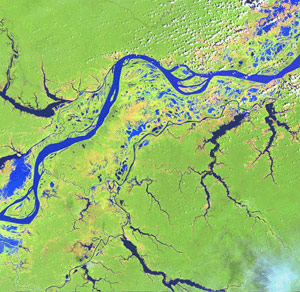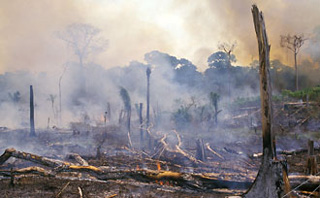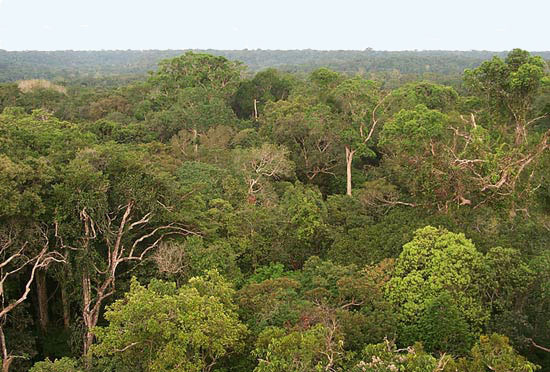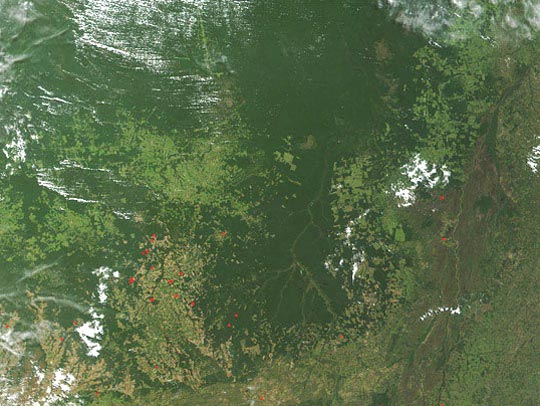|
|

| |
A disaster to take everyone's breath away |
| |
24 July 2006
By Geoffrey Lean
MANAUS - Deep in the heart of the world's greatest rainforest, a nine-day journey by boat from the sea, Otavio Luz Castello is anxiously watching the soft waters of the Amazon drain away.
Every day they recede further, like water running slowly out of an immense bathtub, threatening a worldwide catastrophe.
Standing on an island in a quiet channel of the giant river, he points out what is happening. A month ago, the island was under water. Now, it juts 5 metres above it.
It is a sign that severe drought is returning to the Amazon for a second successive year. And that would be ominous. New research suggests that one further dry year beyond that could tip the whole vast forest into a cycle of destruction.
The day before, top scientists delivered much the same message at a remarkable floating symposium on the Rio Negro, on the strange black waters beside which Manaus, the capital city of the Amazon, stands. |
| |
 |
| |
A Landsat image of the Amazon River, Brazil. Image credit NASA, Landsat.org, Center for Global Change and Earth Observations, Michigan State University
 View larger image View larger image |
| |
 |
| |
They told the meeting - convened on a flotilla of boats by Ecumenical Patriarch Bartholomew of the Greek Orthodox Church, dubbed the "green Pope" for his environmental activism - that global warming and deforestation were pushing the entire enormous area towards a "tipping point", where it would start to die.
The consequences would be awesome. The wet Amazon Basin would turn to dry savannah at best, desert at worst. This would cause much of the world to become hotter and drier. |
| |
 |
| |
In the long term, it could send global warming out of control, eventually making the world uninhabitable. |
| |
 |
| |
Nowhere could seem further from the world's problems than the idyllic spot where Otavio Luz Castello lives. The young naturalist's home is a chain of floating thatched cottages making up a research station in the Mamiraua Reserve, halfway between Manaus and Brazil's border with Colombia.
Rare pink river dolphin play in the tranquil waters around the cottages, kingfishers dive into them, giant, bright butterflies zig-zag across them and squirrel monkeys romp in the trees on their banks.
There is little to suggest that it may be witnessing the first scenes of an apocalypse. The rivers of the Amazon Basin usually routinely fall 9m to 12m - greater than most of the tides of the world's seas - between the wet and dry seasons. But last year they just went on falling in the worst drought in recorded history. |
| |
 |
| |
Slash and burn deforestation to clear land for cattle grazing is just one problem facing Amazon forests. Accidental fire and logging may be damaging as much forest as the amount that is totally deforested.
Rainforest was under little threat from fire before human intervention. Large areas get months of seasonal drought each year, however, forest survived because trees tap moisture 20 metres below ground level. Lightning is the only natural fire trigger, that was followed by rain. Image US Forest Service. |
| |
 |
| |
At one point in the western Brazilian state of Acre, the world's biggest river shrank so far that it was possible to walk across it.
Millions of fish died, and thousands of communities whose only transport was by water were stranded. And the drying forest caught fire; in September, satellite images showed 73,000 blazes in the basin.
This year, says Otavio Luz Castello, the water is draining away even faster than last year - with still more than three months of the dry season to go.
It is much the same all over Amazonia. In Jau National Park, 18 hours by boat up the Rio Negro from Manaus, local people who took me out by canoe at dawn found it impossible to get to places reached without trouble the evening before.
Acre received no rain for 40 days recently, and sandbanks are beginning to surface in its rivers.
Flying over the forest - with trees in a thousand shades of green stretching, for hour after hour, as far as the eye can see - it seems inconceivable that anything could endanger its verdant immensity.
Until recently, scientists took the same view, seeing it as one of the world's most stable environments. Though they condemned the way that, on average, an area roughly the size of Wales is cut down each year, this did not seem to endanger the forest as a whole, much less the planet.
Now they are changing their minds in the face of increasing evidence that deforestation is pushing the Amazon and the world to the brink of disaster. |
| |
 |
| |
|
 |
| |
|
|
Above: Amazon rainforest canopy as far as the eye can see north of Manaus, Brazil.
Image NASA LBA-ECO Project.
 View larger image View larger image
 See also Another Amazon drought raises climate change alarms See also Another Amazon drought raises climate change alarms |
| |
 |
| |
The Amazon rainforest is a driving force of the world's climate .....
Dr Antonio Nobre, of Brazil's National Institute of Amazonian Research, told the floating symposium of unpublished research which suggests that the felling was drying up the entire forest and helping to cause the hurricanes that have been battering the United States and the Caribbean.
The hot, wet Amazon, he explained, normally evaporates vast amounts of water, which rise high into the air as if in an invisible chimney, drawing in wet northeast trade winds, which have picked up moisture from the Atlantic.
This, in turn, controls the temperature of the ocean - as the trade winds pick up the moisture, the warm water left gets saltier and sinks.
Deforestation disrupts the cycle by weakening the Amazonian evaporation which drives the whole process.
One result is that the hot water in the Atlantic stays on the surface and fuels the hurricanes. Another is that less moisture arrives on the trade winds, intensifying the forest drought.
Marina Silva, a fiery former rubber-tapper who is now Brazil's Environment Minister, described how the Government was finally cracking down on the felling by seizing illegally cut logs, closing illicit enterprises and fining and imprisoning offenders.
As a result, it dropped by 31 per cent last year. But that takes it only back to the levels it was in 2001, still double what it was 10 years before.
And it has reached far into the forest after the American multinational Cargill built a huge port for soya three years ago at Santarem.
This encouraged entrepreneurs to cut down trees to grow soya. The symposium flew to inspect the damage this had caused - vast fields of beans destined to feed supermarket chickens in Europe, where until recently there was lush forest.
Brazilian politicians say their country has so many pressing problems that the destruction is unlikely to be brought under control, unless the world helps.
Calculations by Hylton Philipson, a British merchant banker and rainforest campaigner, reckon that doing this would take US$60 billion ($80 billion) a year - less than a third of the cost of the Iraq war.
A fifth of the Amazonian rainforest has been razed completely. Another 22 percent has been harmed by logging, allowing the sun to penetrate to the forest floor, drying it out.
Add these two figures together and the total is perilously close to 50 percent, predicted as the "tipping point" that marks the death of the Amazon. |
| |
 |
| |
Below: A satellite image taken in April 2002 reveals the widespread deforestation (light green and brownish areas) taking place near Mato Grosso, Brazil. Red dots show the locations of actively burning fires. Credit NASA/MODIS Land Rapid Response Team
 View larger image View larger image |
| |
|
Nobody knows when that crucial threshold will be passed, but growing numbers of scientists believe that it is coming ever closer.
One of Nobre's colleagues, Dr Philip Fearnside, says: "With every tree that falls, we increase the probability that the tipping point will arrive." |
| |
The science behind the drought scare .....
Studies by the blue-chip Woods Hole Research Centre, carried out in Amazonia, have concluded that the forest cannot withstand more than two consecutive years of drought without breaking down.
Scientists say that this would spread drought into the northern hemisphere and could massively accelerate global warming with incalculable consequences.
The research - carried out by the Massachusetts-based centre in Santarem on the Amazon River - has taken even the scientists conducting it by surprise. |
| |
 |
| |
The immense forest contains 90 billion tons of carbon, enough in itself to increase the rate of global warming by 50 per cent. |
| |
 |
| |
When Dr Dan Nepstead started the experiment in 2002 - by covering a chunk of rainforest the size of a football pitch with plastic panels to see how it would cope without rain - he surrounded it with sophisticated sensors, expecting to record only minor changes.
The trees managed the first year of drought without difficulty. In the second year, they sunk their roots deeper to find moisture, but survived.
But in year three, they started dying. Beginning with the tallest the trees started to come crashing down, exposing the forest floor to the drying sun.
By the end of the year the trees had released more than two-thirds of the carbon dioxide they have stored during their lives, helping to act as a break on global warming. Instead they began accelerating the climate change.
The Amazon now appears to be entering its second successive year of drought, raising the possibility it could start dying next year.
The immense forest contains 90 billion tons of carbon, enough in itself to increase the rate of global warming by 50 per cent.
Nepstead expects "mega-fires" rapidly to sweep across the drying jungle. With the trees gone, the soil will bake in the sun and the rainforest could become desert.
Deborah Clark from the University of Missouri, one of the world's top forest ecologists, says research shows "the lock has broken" on the Amazon ecosystem and the Amazon is "headed in a terrible direction". |
| |
 |
| |
Copyright © Independent News & Media. This article was first published in The Independent 24/7/2006.
|
|
 |
| |
 |
|



